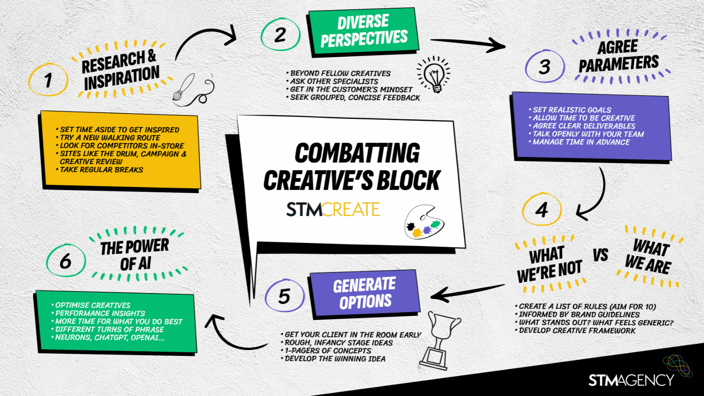From Unblocking Writer’s Block to Unlocking Potential: Top Tips for Creative Excellence on Fast-turnaround Briefs
As deadlines become more reactive and fast-paced, it’s crucial to work in an agile manner. In this blog, we share some top tips to add structure to your creative process, helping you hit the ground running.
You’ve been given a creative brief: a new brand identity, launching a product on social, and writing a batch of product descriptions. The deadline is yesterday. As creatives, it’s natural for the age-old writer’s block to kick in when time is against us. The designer panic. The piles of screwed-up paper mounting in the proverbial bin.
Being shorter on time can lead us to panic, and to doubt ourselves. How will you land on that golden idea in time?
The challenge is: how do you overcome this instinct and maximise the time you do have, to deliver an output or an idea you’re satisfied with, and which delivers on the brief?
It’s about being realistic and breaking down your thinking. Not cutting corners but instead building concrete steps into your process to pace the development of those ideas. To test their strengths and ultimately give you confidence in your final decision.
Our Creative team have collated six tried-and-tested tips for adding some structure to your ideation, helping you nail those fast-turnaround briefs the first time:

1. Take time to absorb knowledge and inspiration
No great idea has been borne from having your head buried in the sand. As you would for any larger-scale project, carve out some time at the beginning of the process to do some research.
A part of this can be research in the traditional sense. Getting stuck into the brand, their positioning, their history, their consumers. Get to know their competitors and what they are doing differently across the media landscape.
Then go broader. As creatives, inspiration comes to us from all manner of places, and through all the senses. Pop out for a walk, look up and around. Opt for a route you don’t usually take. If you’re working on an FMCG brand, head to your local supermarket and get a feel for what’s on the shelves. Or if you’re staying closer to home (or the office), sites like The Drum, Campaign and Creative Review all have best-in-class, real-world creative ideas and executions in spades.
Continue taking these breaks and opening your mind over the course of your project. Even the most skilled creative’s batteries need recharging every so often, and not only will taking some time away from your desk do just that - you might just find the answer you were looking for along the way.
2. Bring a range of voices into the room
This is one we’d apply to all creative sprints.
When it’s time to consult your team and get a second opinion, consider exactly who is best to bring into the conversation, and when. Keeping in regular contact with your team and client is a sure-fire way to keep you focused and confident when working to tight timings.
It’s not always other likeminded creatives you should consider here. Yes, getting a second opinion from someone from your team, with experience in similar projects, is extremely useful. But getting a copywriter’s thoughts on a design concept, or a photographer’s view on a social strategy, can provide invaluable insights you might not have thought of.
Go even broader. Borrow the eyes (or ears) of people outside the Creative team, to study the work objectively. Does it make sense? Is the message being interpreted in the way it was intended? Seek diverse perspectives. Get in the head of the end consumer, who may look at things differently.
It’s important to note: feedback shouldn’t overcomplicate the process when working to a tight deadline. Keep consulted stakeholders limited to a manageable amount. Encourage them to come together and come back to you with a single, consolidated list of actions and suggestions, to avoid conflicting opinions. It’s everyone’s responsibility to ensure the swift and efficient running of the creative process, not just yours.
3. Set and agree parameters for your deliverables
Here’s where it’s time to start putting pen to paper (or fingertip to key, or paint to canvas, or whatever your preferred method – no judgement here). It can feel overwhelming when a rapid turnaround lands on your desk, but there are opportunities here too. Reactive creativity can spark some of the brightest raw ideas. It forces you to be precise and brutal in your thinking.
To tackle that sinking feeling of too many options, and too little time, it’s a good idea to be practical in the first instance and honest with yourself – and your team – about what is achievable in the time you’ve been given.
With your knowledge and experience from previous projects, what is the maximum volume of deliverables you can create, whilst giving yourself sufficient time to stop and think, for testing and development? Be realistic, and ringfence the time you do have to deliver a manageable amount of quality work, rather than spreading yourself too thinly.
If it’s a tone of voice project, perhaps it’s a toolkit with an introductory narrative and some sample copy lines, rather than a 20-page document. If it’s a social campaign, maybe it’s creating a series of templates which can be rolled out and expanded upon over the course of a project, rather than 15 bespoke assets upfront (which may all require amends later down the line anyway).
Obviously, each project is unique, and you must agree on all of this with your team and client beforehand. But it’s vital, both for your own wellbeing and to achieve an optimal project outcome, that you are upfront with your boundaries. You’ll feel confident – and more creative – from the outset, and any feelings of anxiety will already start to subside.
4. The ‘What We’re Not’ is as useful as the ‘What We Are’
You’ve done your research. You’ve consulted your team and agreed on what you’re delivering and set yourself some reasonable parameters to manage your time most effectively. Now you’re ready to formulate those ideas.
Whilst it’s great to be open-minded and leave nothing off the table at the earliest stages of the ideation process, when in a pinch for time, it can be equally handy to create some rules about what your brand is not, and what shouldn’t feature in your work.
Setting some rules and restrictions can aid creativity. See it not as putting yourself in a box but as giving yourself some safety barriers to keep you on the straight and narrow. It’ll give you something to hold onto, some parameters to think around.
Use your knowledge of the brand and their competitors to help formulate these. As well as listing off-brand components that clearly go against guidelines or tone of voice, consider the wider landscape. What would look or sound too generic and ultimately say nothing at all? Does that colour or backdrop convey enough seasonality?
Aim for ten rules and see where you get. Don’t spend too long on this – but it’ll give you a framework so you can start mapping-out your thoughts and check they’re all in the centre of the Venn diagram.
5. Generating creative routes can help with the sift
If your brief is broad and, when you’re getting into it, you find you have two or three strong ideas that sit separately from one another, it doesn’t always have to be a case of killing your darlings straight away.
In fact, to avoid rework later down the line, it’s sometimes beneficial to get your team or client in early and run them past your ideas, and get a feeling for their preference. Even if it involves spit-balling a few looser, infancy-stage ideas to help reduce these down. Don’t worry about rough at this stage. It’s the core idea that counts.
A short deck, or a couple of quick one-pagers with a summary of the creative approaches, can work well here. Hop on a call all together if you can, chat through them, and from there refine down to the single idea that wins the crowd. It might be that elements of more than one concept are liked. If this is the case, use your rationale as to whether these can be combined into a single, unified approach, or, if not, make a recommendation from there as to which to expand into a full response.
As we mentioned earlier, keeping your team in regular contact, and collaborating closely, is a good idea throughout these faster-turnaround projects. Not only does this keep all stakeholders engaged, but it will also give you, as the creative, the confidence that you are on the right track, with the relevant people consulted.
6. Harness the power of AI
These two letters spark fear into even the most technologically savvy of creatives – often unnecessarily. We shouldn’t recognise AI platforms as the enemy of creativity, or as a replacement for what we do, but as extra tools in our arsenal. They can provide valuable suggestions and alterations at the push of a button, which is especially beneficial when time is of the essence.
Tools like Neurons are a reliable sidekick for quickly providing insights and suggested improvements on a piece of creative. Objectively, they can suggest platform-specific alterations to improve performance or legibility, even heat-map the areas of creatives based on where customers’ eyes are falling.
Similarly, rather than dusting-off your thesaurus, tools like ChatGPT can quickly generate alternative wording options when you’re struggling to find the right turn of phrase or looking to avoid repetition. These sorts of efficiencies allow you to spend the time you do have doing what you do best, rather than sweating the small stuff.
At intervals, it’s worth using the tech resources you have to hand to optimise your creatives and refine as you go. This way, you can present your work with confidence that the idea will perform, and the maths to prove it in your back pocket.
In Summary
With all these processes at your disposal, the next time a challenging brief comes your way, you can rest assured that adding a little more structure to your creative ideation process will help keep the creative blocks we’ve all experienced at some point in our career at bay.
Looking to rebrand? Launching a new product, or a reactive campaign? Get in touch today! Our Creative team will work alongside you to develop fresh, thumb-stopping ideas that perform, at pace.

From Unblocking Writer’s Block to Unlocking Potential: Top Tips for Creative Excellence on Fast-turnaround Briefs
Fast-paced deadlines demand agile creative processes. In this blog, we share actionable tips to help structure your ideation, overcome writer’s block, and confidently deliver fast-turnaround briefs.




